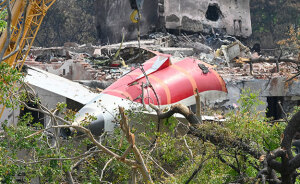Years ago, we first laid our eyes on the stunning photographs that Jimmy Nelson published in his book "Before They Pass Away" that gave us a look at over 30 vanishing native tribes from all around the globe. From Mongolian to Indian tribes, Jimmy spent weeks with each group to learn their culture, capture it from his point of view and collect interesting facts.
In 2018, Nelson published his second major project titled "Homage to Humanity." He visited 34 isolated tribes in five continents, revisiting some from his previous journey. While his first book was a collection of pictures, this time the photographer decided to expand and added travel journals, maps, local facts, and personal interviews, shifting the focus of his story from the objects he captures to the journey itself.
"When I was 17, I started a journey, and it's still the journey that I'm on today," Nelson said. "It's about reconnecting and finding myself. I've dressed it and disguised it with photography and tribes and indigenous cultures, but ultimately it's a very personal journey of wanting to feel and survive and be alive."
In his work, Jimmy explores the idea of reconnecting to our roots and our humanity, and he believes that indigenous people play an important role in our perception of ourselves as human beings. That's why he's inviting everyone to join the global discussion on cultural identity. The more you know about the world around you, the easier it is to accept and appreciate it. In a couple of weeks, Jimmy Nelson is planning to release a movie featuring 1500 photographs, "all stitched together into one amazing journey across the cradle of human culture."
More info: jimmynelson.com
This post may include affiliate links.
Hakamou'i, Ua Pou, Marguesas Islands, French Polynesia
Wow! Goosebumps! These people are so free! Free from all the s**t of our world- technology, money, politics!
What a wonderful collection! I would like to see all of them in greater detail intricate and elaborate clothing,face painting ,head wraps.The book would be very interesting. Thank You!
They look like the real-live version of the blue people from avatar, in a good way!
Yang Shuo Cormorants, China
It looks like scene from some kind of myth or legend. Gloomy river and its guards, peaceful but fierce - if necessary. I love these lanterns - they gives such small amount of light and still it is impressive (I love that most colours here are greyish, that is beautiful). Amazing photo.
I don't know if this a photo about isolated a tribute. They're probably just local fishermen, in one of the most traveled place in China. Cormorant fishing is cool though.
Wow - never knew this was a thing -https://en.wikipedia.org/wiki/Cormorant_fishing
I saw a thing on tv a while back about it, very interesting
Load More Replies...Aahh yes the fishing Cormorants I have seen this before it is incredible how they work them.
Samburu Tribe, Kenya
Are those gala spears or are they in use in real fights and huntings? I like this photo very much. You managed to make it look simultaneously peacefuly and somewhat dangerous, which (as I thought) is impossible. I'm stunned.
The Samburu people from my native country Kenya use the Spears to defend themselves against threat,to hunt for game meat or kill lions and other predators when they attack their herds of animals. Oh and they use the Spears to dig up roots that they use as medicine.
Load More Replies...I don't know if those kind of skirts are comfortable to run
Load More Replies...nice Jimmy . i admire your picture. i would like to have this on a cd label .
Mask Dancers, Paro, Bhutan
These guys are not from an isolated tribe, they perform at festivals. Paro is the second largest town in Bhutan and has an international airport!
As long as there are monks in Bhutan, mask dancers will always be there. They are not a tribe and certainly not isolated. In remote villages, if there are no monks in the monasteries, the locals/villagers carry on this task during festivals. With tourism booming, there are now many local dance troops learning the art and are performed for tourists on demand. Although I don't agree with that part as these dances are usually part of our Tshechus (religious festivals) and one must be part of the Tshechus to truly understand its significance.
Behind in the background is a monastery perched on a hill, called the Paro Taksang or Tiger's Nest - one of Buddhism's most important figures Guru Padmasambhava came from the Indian sub-continent and introduced Buddhism to Bhutan is said to have meditated at this place for 3 years, 3 weeks and 3 days. There's not a lot of historical records on his life, but Buddhism in Bhutan is said to have been transmitted from his teachings.
Your photography and the way you capture these images is stunning. 📷
Thats tiger's nest behind on the mountain.. what a beautiful country Bhutan is..
Perak Women, Thikse Monastery, Ladakh, India
I want to know whats behind them...are they snow/ice huts? or sculptures? and what are they used for? hopefully google can help me out.
A stupa (Sanskrit: "heap") is a mound-like or hemispherical structure containing relics (such as śarīra – typically the remains of Buddhist monks or nuns) that is used as a place of meditation. Whew! now we all know :)
Load More Replies...That is an incredible amazing picture. Fantastic! But these are Ladakh women wearing a Perak (https://en.wikipedia.org/wiki/Perak_(headdress)). That is not an isolated tribe.
Wow! This amazing photograph, explains beautifully how you cannot put everyone in the same basket...Who would think this is India?
Those are Chorten "Small temples called chorten are found everywhere in Tibet. The design can vary, from roundish walls to squarish, four-sided walls. Some of these temples have relics of monks or other precious items. They are decorated with different depictions of the elements and nirvana symbolizing when the Buddha reached enlightenment. There are eight types of chorten, but only two-three are common in Tibet. It is considered a good deed of merit to either restore the temple or to walk around the temple in a clockwise direction." Ladakh is culturally continuous with Tibet.
I like that. "Silver Women". Sounds beautiful. They are beautiful.
Load More Replies...Snow in North, Wettest place in earth in North East, hot desert North West, fold mountains North, Volcanic Mountains south, active volcanoes on eastern islands, etc etc .. should give you fair idea of the Geography of India.
Load More Replies...Vaioa River, Atuona, Hiva Oa, Marquesas Islands, French Polynesia
Mmmm, gorgeous men on horses in nature dressed in their cultural garb? Yes please!
Khoyor Tolgoi Hill, Altan Tsogts County Bayan Ulgii Provence, Mongolia
Are these the Mongolian eagle or falcon guys recently featured on Nova or Nature on PBS?
I saw that and it was amazing. The competition is a yearly event. This program showed a little girl and her eagle. I believe she won the competition.
Load More Replies...There was a wonderful film a few years ago about a young Mongolian girl who is a champion Eagle huntress- a revolutionary idea for their culture- if you can find it I highly recommend watching it-really gorgeous film! "The Eagle Huntress"
Nah, that's Bilbo and the gang when the eagles dropped them off in the middle of nowhere, instead of flying them for another 10 minutes directly to the Lonely Mountain :D
Crazy how their ancestors conquered half of the Eurasia with Genghis Khan...
The Mongolian hunters with their Eagles most of which are female. Just beautiful
Huli Wigmen, Ambua Falls, Tari Valley, Papua New Guinea
They look ferocious with those yellow painted masks. Fascinating.
I believe they used to be Cannibals ( head hunters) I do not think they are now but they certainly look fierce.
Ni Vanuatu Men Rah Lava Island, Torba Province Vanuatu Islands
Tarangire, Rift Escarpment, Tanzania
Such bright colours! They contrast with the rest of the photo in a very beautiful way. I like this landscape in the background and how it looks so empty on the right side and everything on the left. Somehow this makes this photo looks even more balanced and beutiful.
Your comment made me appreciate this photo so much more!
Load More Replies...Aaaand looking at their masks, I realize, the internet has ruined me XD
Uhm Tarangire is not a isolated tribe definitely, they are Maasai warriors prepared for Eunoto ceremony (the masks, then). But hell matters, they are absolutely awesome.
These are the same Maasai people that ou have higlighted earlier and they are by no means "Isolated"
Ganges, Haridwar, India
Actually Megan, i can dit anywhere, i have hemmerhoids... (it's a Vine, nothing personal!!!)
Load More Replies...Ndoto Mountain Range, Kenya
These guys are READY! And we can't even drink the water without getting sick!
Angge Village, Upper Mustang Nepal
Dream world. Just gorgeous. I wish I could see this is person but I know that it's a super long journey that is beyond my scope. I think That's why I appreciate this photo series so much...
I'd like to see all of them in person, too. Afterwards I think that if many people have the same idea it'd be not nice to them to have, lets say, so many visitors. And of course we'd need a lot of time and money...
Load More Replies...The sunset alone is something out of a space planet pic! Ima in awe of the caption and the temples! Truly a sight to see!
To you folks commenting on visiting this space, I recommend Yak Butter & Black Tea - Great read- https://www.barnesandnoble.com/p/yak-butter-and-black-tea-wade-brackenbury/1111892669/2675999526367?st=PLA&sid=BNB_New+Marketplace+Shopping+Books&sourceId=PLAGoNA&dpid=tdtve346c&2sid=Google_c&gclid=Cj0KCQiA3b3gBRDAARIsAL6D-N9GXoCzJcEl1x3uq63zyRmPTp04WuoFsG-10NIBpCLsVxdcRjp5es0aAmj5EALw_wcB
Te Aroha Mikaka & Sky Bay Of Islands, Haruru Falls, North Island, New Zealand
Yes, but he seems a little out of place too, due to his dress. Like he doesn't belong to the group
Load More Replies...Gorgeous. To think that once upon a time, all of New Zealand looked and lived like this. Such a strange, mysterious way of being it seems to us settlers.
This is a staged picture. Bay of Islands is not isolated. It’s a tourist centre.
Remarkable photo, like most from this collection but it seems a bit too staged, like most from this collection, to be a real representation of indigenous tribes as they are today (or when the photos were taken). I mean, people are not walking around dressed like that in their everyday lives.
People don't walk around in their wedding dresses every day either, but we still photograph it and value it as a representation of something larger.
Load More Replies...Likekaipia Tribe Ponowi Village, Jalibu Mountains, Western Highlands, Papua New Guinea
Uramana Clan, Amuioan, Tufi, Papua New Guinea
Miao Village, Liu Pan Shui, Gui Zhou, China
actually only women can wear those "fancy hats", as they are from the Miao Longhorn tribe. Those head pieces are an intricate of hair wrapped around real horns and then they add a bun of wool, linen and sometimes also ancestral hair.
Load More Replies...Sure, sure, tradition. But when I tie my pillow to my head to be able to sleep wherever, I'm just nuts
Yes, yes you are. lol But that's okay, I'm nuts too. We all are. : )
Load More Replies...Those 4 are too shy to be photographed? Just joking, I'm sure there is a reason. Does anyone know?
These are Miao (outside of China called Hmong). Far over 10 million people. Amazing people, amazing history. But please - the opposite of an isolated tribe...
Paro Pass, Bhutan
This is not paro pass. This is chele la pass situated in the paro-bonday-haa highway.
This is the true forbidden place. Not easy to get permission to visit the country. They are keen on preserving the natural beauty.
I appreciate the immense cultural value of these photos, simply stunning images...an incredible project, wow...but I can't help feeling heart broken to see these people barefoot on the bare rock of the cold, rough mountain. Shoot me down if I'm too ignorant :(
People in Bhutan wear shoes, but mask dancers don't wear shoes while performing, maybe they took it off for this photo as well.
Load More Replies...There are prayer flags everywhere in Bhutan, adding vibrant color to the beautiful sceneries
those are prayer flags - they have prayers written on them and each time the wind makes them flutter, it is counted as having said the prayer once
Load More Replies...Again unrelated but I think Bhutan is a nice get away for introverts
Mount Bosavi Waterfall, Papua New Guinea
I don't know anyone who needs to be taught how to pose.
Load More Replies...Korcho Village, Omo Valley, Ethiopia
Being Indigenous doesn't mean living in the past and living out your colonial fantasies.
Load More Replies...Beautiful pics but would be even better if there were more women represented.
Lake Argentino / Cerro Christal On Horizon Patagonia, Argentina
Even if they aren't a Tribe, it's still a very good picture. And I am sure that at some time in the FAR DISTANT PAST they were a tribe of some sort. So stop hating on this picture.
I can’t imagine how much time goes into bringing us even one of these photographs; the time to travel there, the gaining of trust of the people and the setting up. It is a labor of love and respect and I am privileged that with one tap on a screen I can get to see this. Thank you for broadening my horizons.
I agree. It is truly amazing what we are shown here ❤
Load More Replies...It is sad that these tribes are disappearing because people are pushing them out of their home.
This can happen as well as with so many animals, it's about GREED !!!
Load More Replies...Amazing pictures of indigenous tribal dress. A shame that, apart from ceremonies and photographs, many of them will be wearing western garb in everyday life. Long may they keep their traditions alive.
I'm from Kenya but not from the same tribe but majority of the Masai tribes that you saw in the different pictures do actually live and dress like that on a daily basis. There is very few, usually the younger generation that move to the city and try living a modern life and wearing westernized clothing. They're probably one of the very few tribes that remain indigenous in the entire country and continent.
Load More Replies...I figured that I've a problem imagining everyday life of people from other cultures. I am so used to Western lifestyle that when I try to think about other possibilities I have serious problems. Shame on me that I am so concentrated on my own cultural circle and so ignorant when it comes to others. Presentations like yours shows me that there are other cultures with their own traditions, beliefs and lifestyle. I know that on your photos people are wearing their festive clothes and jewelry and that their everyday life looks very different but still your work shows me something different and unknown, makes me curious and wanting to know more. Thank you for your work and these beautiful photos.
I remember visiting Kenya 25 years ago. The local craftsmen (stone and wood-carvers) and fruit sellers were obsessed with western clothing - anything with a logo on it.Would literally have the shirt off your back. Honestly "not want money - want T shirt" pointing at what you were wearing. We learned to take or wear a spare top when shopping- barter system in action. Came home with lot fewer clothes but some nice African art.
It was sad that they wanted to exchange the fruits of several days work for a cheap T shirt
Load More Replies...What a bunch of lame people, they ought to update things to our hip contemporary ways and start drinking SBX and using smart phones and listening to Kanye! Srsly though, while traditional tribal cultures are of incredible value and we should learn from them and document their culture, we shouldn't assume from these photos that these cultures are endlessly peaceful and happy and egalitarian. That view has derisively been called the Noble Savage theory, and in the case of many hunter-gatherer or pre-modern societies around the world, it is highly inaccurate. Many pre-modern societies are wracked with bloody conflicts, can be extremely patriarchal and chauvinistic to women, can have the same moments of unhappiness and small mindedness that we have in our modern world.
Any photos from the North Sentinel?...No?! :P On a serious note though- these photos are gorgeous. I can imagine how hard it was to approach them and communicate with them to get these pics done.
where is the untouched andaman & nicobar islands sentinelese tribe. They should be on number one
What is actually the most impressive part to me, is that not a person looks obese. can you imagine the 3rd world problems that they avoid, like obesity. I find it amazing, beautiful and glad that someone has shared and documented this.
I noticed one lady in #17 who is big. She could be pregnant, though.
Load More Replies...I can’t imagine how much time goes into bringing us even one of these photographs; the time to travel there, the gaining of trust of the people and the setting up. It is a labor of love and respect and I am privileged that with one tap on a screen I can get to see this. Thank you for broadening my horizons.
I agree. It is truly amazing what we are shown here ❤
Load More Replies...It is sad that these tribes are disappearing because people are pushing them out of their home.
This can happen as well as with so many animals, it's about GREED !!!
Load More Replies...Amazing pictures of indigenous tribal dress. A shame that, apart from ceremonies and photographs, many of them will be wearing western garb in everyday life. Long may they keep their traditions alive.
I'm from Kenya but not from the same tribe but majority of the Masai tribes that you saw in the different pictures do actually live and dress like that on a daily basis. There is very few, usually the younger generation that move to the city and try living a modern life and wearing westernized clothing. They're probably one of the very few tribes that remain indigenous in the entire country and continent.
Load More Replies...I figured that I've a problem imagining everyday life of people from other cultures. I am so used to Western lifestyle that when I try to think about other possibilities I have serious problems. Shame on me that I am so concentrated on my own cultural circle and so ignorant when it comes to others. Presentations like yours shows me that there are other cultures with their own traditions, beliefs and lifestyle. I know that on your photos people are wearing their festive clothes and jewelry and that their everyday life looks very different but still your work shows me something different and unknown, makes me curious and wanting to know more. Thank you for your work and these beautiful photos.
I remember visiting Kenya 25 years ago. The local craftsmen (stone and wood-carvers) and fruit sellers were obsessed with western clothing - anything with a logo on it.Would literally have the shirt off your back. Honestly "not want money - want T shirt" pointing at what you were wearing. We learned to take or wear a spare top when shopping- barter system in action. Came home with lot fewer clothes but some nice African art.
It was sad that they wanted to exchange the fruits of several days work for a cheap T shirt
Load More Replies...What a bunch of lame people, they ought to update things to our hip contemporary ways and start drinking SBX and using smart phones and listening to Kanye! Srsly though, while traditional tribal cultures are of incredible value and we should learn from them and document their culture, we shouldn't assume from these photos that these cultures are endlessly peaceful and happy and egalitarian. That view has derisively been called the Noble Savage theory, and in the case of many hunter-gatherer or pre-modern societies around the world, it is highly inaccurate. Many pre-modern societies are wracked with bloody conflicts, can be extremely patriarchal and chauvinistic to women, can have the same moments of unhappiness and small mindedness that we have in our modern world.
Any photos from the North Sentinel?...No?! :P On a serious note though- these photos are gorgeous. I can imagine how hard it was to approach them and communicate with them to get these pics done.
where is the untouched andaman & nicobar islands sentinelese tribe. They should be on number one
What is actually the most impressive part to me, is that not a person looks obese. can you imagine the 3rd world problems that they avoid, like obesity. I find it amazing, beautiful and glad that someone has shared and documented this.
I noticed one lady in #17 who is big. She could be pregnant, though.
Load More Replies...
 Dark Mode
Dark Mode 

 No fees, cancel anytime
No fees, cancel anytime 






























































































